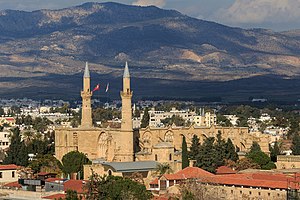Selimiye Mosque (Nicosia)
| Selimiye Mosque | |
|---|---|
| Selimiye Camii / Τέμενος Σελιμιγιέ | |
 |
|
| Basic information | |
| Location |
de facto North Nicosia, Northern Cyprus de jure Nicosia, Cyprus |
| Geographic coordinates | 35°10′35″N 33°21′52″E / 35.1765°N 33.3645°ECoordinates: 35°10′35″N 33°21′52″E / 35.1765°N 33.3645°E |
| Affiliation |
|
| District |
de facto Lefkoşa District de jure Nicosia District |
| Year consecrated | 1326 |
| Status | Active as a mosque |
| Architectural description | |
| Architectural style | Gothic |
| Groundbreaking | 1209 |
| Specifications | |
| Capacity | 2500 |
| Minaret(s) | 2 |
Selimiye Mosque, historically known as Cathedral of Saint Sophia, is a former Roman Catholic cathedral converted into a mosque, located in North Nicosia. It is the main mosque of the city. The Selimiye Mosque is housed in the largest and oldest surviving Gothic church in Cyprus (interior dimensions: 66 X 21 m) possibly constructed on the site of an earlier Byzantine church.
In total, the mosque has a capacity to hold 2500 worshipers with 1750 m2 available for worship.
The name of the cathedral derives from Ayia Sophia, meaning "Holy Wisdom" in Greek. According to Kevork K. Keshishian, the dedication of the cathedral to the Holy Wisdom is a remnant from the Byzantine cathedral, which occupied the same place. However, such a cathedral is absent from Byzantine sources and is not associated with any excavated ruins. In spite of this, there is evidence of the existence of such a cathedral; an 11th-century manuscript mentions the existence of an episcopal church dedicated to Holy Wisdom in the city.
The construction of the cathedral began in 1209, when Thierry, the Archbishop of Cyprus, lay the foundations of the cathedral, however, there are claims of evidence indicating an earlier beginning date. Halil Fikret Alasya, however, credits Eustorge de Montaigu, the Archbishop of Cyprus during the early years of the Frankish rule with the commencement of the construction. in 1208, By 1228, the church was "largely completed" under Eustorge. The arrival of Louis IX of France in Cyprus in 1248 for the Seventh Crusade gave a boost to the construction. By the end of the 13th century the side aisles and a large part of the middle aisle were completed.
During the 13th and 14th centuries, the cathedral was damaged twice by earthquakes, in 1267 or 1270 and 1303. The 1267/1270 earthquake caused significant delay in the construction of the nave. Giovanni del Conte, Latin archbishop of Nicosia, oversaw the completion of the nave and the narthex until 1319 and that of the middle aisle, the buttresses of the chevet, the façade and a chapel/baptistery from 1319 to 1326. He also initiated the adornment of the cathedral with frescoes, sculptures, marble screens and wall paintings. In 1326, the cathedral was finally consecrated and officially inaugurated with a great celebration.
...
Wikipedia
